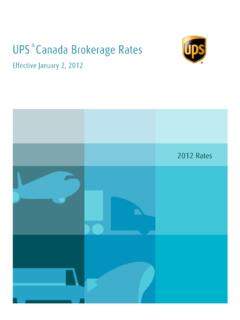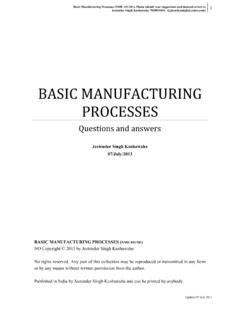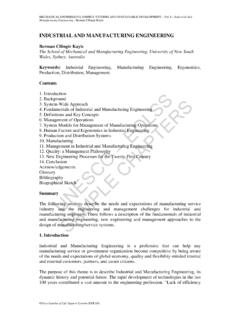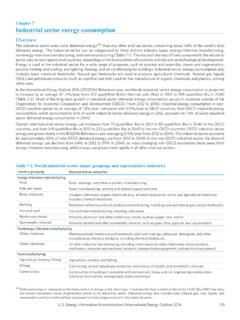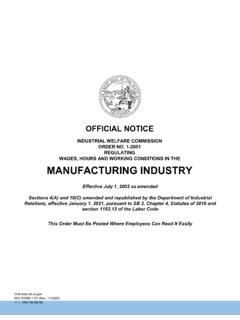Transcription of 3D Printing: The Next Revolution in Industrial …
1 3d printing : The next Revolution in Industrial manufacturing NEW RESEARCH FROM UPS AND THE CONSUMER TECHNOLOGY ASSOCIATION (CTA) 3d printing : An overnight success?The technology for 3d printing has roots that go back decades. The minds behind it were visionary. But for many years, 3d printing appeared at least in the mainstream view to be more of a novelty than a practical tool to advance commercial manufacturing . 3D printers created one-off trinkets, souvenirs and not much else. And business leaders often were skeptical that 3d printing would ever advance enough to be an integral part of , we are now seeing that 3d printing has reached an inflection point as lower costs and technological advances have put it within reach of more people.
2 That s the most common use because it allows for a more agile design process and rapid product iterations. Some of the more progressive users are exploring larger-scale parts production for existing products. Meanwhile, we at UPS are taking a closer look at 3d printing as a complement to our supply chain and logistics business. We ve long recognized the disruptive potential of 3d printing , and we intend to help the customer supply chain stay ahead of the recently partnered with the Consumer Technology Association (CTA) to conduct in-depth interviews with companies that are early or recent adopters of 3d printing .
3 We wanted to learn more about the factors that influence the adoption of 3d printing . This study also compiles published research and forecasts from thought leaders and conclusion: 3d printing presents compelling business opportunities. Companies that wait too long to explore the potential could be missing is proud to present this study, which offers valuable insights into the current and future trends for Industrial 3d printing . Derrick Johnson Vice President of Marketing at UPSINTRODUCTIONINTRODUCTIONMARKETCOMPOSI TIONEXPERT PERSPECTIVESINDUSTRY CASE STUDIESWHAT S next IN 3D PRINTING3D printing VS.
4 TRADITIONAL MANUFACTURINGPAGE 2 Researchers estimate that the 3d printing market will reach $ billion in 2016. The primary market including 3d printing systems, materials, supplies and service has grown at least 30% each year from 2012 to 2014. The rest of the growth comes from the secondary market, including tooling, molding and countries (North America and Europe) account for more than two-thirds (68%) of the 3d printing market revenue and Asia Pacific accounts for 27%. The consumer electronics and automotive industries each contribute 20% of the total 3d printing revenue. These early-adopter industries use the technology primarily during the prototyping stage of production.
5 For example, smartphone manufacturers are slowly using 3d printing for more than just prototyping some component parts are now manufactured with 3D medical device industry (15%) is the third largest 3d printing market and uses 3d printing for mass customized finished goods such as hearing aids. Interesting fact: 98% of hearing aids worldwide are manufactured using 3d printing . MARKET COMPOSITION3D printing is a Multi-Billion Dollar Market and Growing3D printing Market Revenue by Geography27%28%Asia/PacificEuropeSOURCE: Wohlers Report 2015: 3d printing and Additive manufacturing State of the Industry Annual Worldwide Progress Report , Wohlers Associates, 3$21B$6B$7B$13B$4B201320142016201820203D printing : A $ billion marketThe hearing aid industry converted to ~100% 3d printing in less than 500 AmericaINTRODUCTIONMARKETCOMPOSITIONEXPE RT PERSPECTIVESINDUSTRY CASE STUDIESWHAT S next IN 3D PRINTING3D printing VS.
6 TRADITIONAL MANUFACTURINGM anufacturing, a market ripe for disruptionDespite significant growth, there is a wealth of untapped potential in 3d printing . In fact, 3d printing represents only of the global manufacturing market, with prototyping as the leading use today. Wohler s and Associates believes 3d printing will eventually capture 5% of the global manufacturing capacity, which would make 3d printing a $640 billion of the opportunity lies in parts production the fastest-growing 3d printing application. The use of 3d printing for parts production grew from virtually zero in 2003 to 43% ($ ) of global 3D-printed product and service revenue in 2014.
7 3D-printed parts are currently being used most for functional parts (29%), prototypes (18%) and visual aids (10%). This is a market ripe for disruption. Technology adopters that move beyond prototyping to use 3d printing in supporting and streamlining production can achieve new manufacturing efficiencies. Plus, there is an enormous opportunity for companies that get it COMPOSITIONSOURCE: Wohlers Report 2015: 3d printing and Additive manufacturing State of the Industry Annual Worldwide Progress Report , Wohlers Associates, 4In 2015, 3D-printed manufactured goods represented less than 1% of all manufactured products in the parts Fit and finish componentsVisual proof of conceptMolds and tooling29%18%10%10%Top Uses for 3D-Printed GoodsINTRODUCTIONMARKETCOMPOSITIONEXPERT PERSPECTIVESINDUSTRY CASE STUDIESWHAT S next IN 3D PRINTING3D printing VS.
8 TRADITIONAL MANUFACTURINGP rototypingProduct developmentInnovationIncreased efficiencyCost reduction25%16%11%10%9%Technology trade-offs3D printing is not a one-size-fits-all solution. For high volume, standardized applications, traditional manufacturing is likely the answer. When is 3d printing the answer? The top reasons for pursuing 3d printing are: prototyping (25%), product development (16%), and innovation (11%) 3d printing can speed development and delivery for customized products and bring increased flexibility through better inventory management and real-time production of products with variable demand.
9 Other advantages include manufacturing advantages for small batches, cost advantages based on efficiencies for certain applications and unprecedented flexibility in new printing also can improve quality through lighter parts, better ergonomics and more design freedom. However, low process stability can negatively impact quality; and low reproducibility can negatively impact product durability. It s critical to consider needs and priorities to make the decision between 3d printing and traditional manufacturing . Like everything else, there are benefits and trade-offs. 3d printing VS. TRADITIONAL MANUFACTURINGPAGE 5 Top Reasons to Pursue 3D Printing3D printing is displacing some traditional manufacturing methods such as metal extrusion, computer-controlled machining and manual modeling techniques for prototype development PERSPECTIVESINDUSTRY CASE STUDIESWHAT S next IN 3D PRINTING3D printing VS.
10 TRADITIONAL MANUFACTURING3D printing vs. Traditional ManufacturingSmall batch, Highly customizedLarge batch, Not customizedHigh variable costs, No fixed costsLow variable costs, High fixed costsVery fast ( 1 day)No higher than simple partsVery slow to moderately slowMuch higher than simple parts3D PRINTINGTRADITIONALCOST PER UNITTIME TO MARKETCOST OF COMPLEXITYVOLUME3D printing adoptionCurrent Users: Two thirds of manufacturers already use 3d printing in some way, and 25% plan to adopt the technology in the future. Despite these numbers, the full potential of 3d printing is far from : Thirty-two percent of current users don t believe their company is fully leveraging the advantages of 3d printing while 45% of intenders would use the technology more if benefits were better understood by their company.



